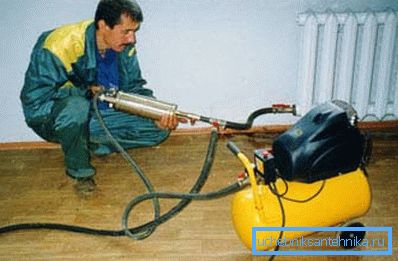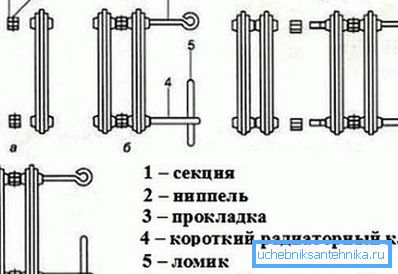Characteristics of cast iron heating radiators: types and
The weight and dimensions of the cast-iron radiators of heating will primarily depend on the number of sections in one device, but these same sections can also differ from each other radically, since they are one, two or three channels.
But, despite the bulkiness, batteries from cast iron are very much in demand for water systems of centralized heating, as they fully correspond to the necessary parameters for heat transfer and durability at any possible jumps in the pressure of the heat carrier.

It is about these devices, acquaintances, probably, to every citizen of Russia who has reached the conscious age, and this will be discussed, and we will also show you a video in this article.
Cast Iron Radiators
The cast iron radiator is a convection-radiation columnar heating device that is assembled from several sections. It was invented by Franz San Galli in 1857.
Types and designs

- As we have already said, how much a cast iron radiator weighs, as well as its volume, directly depends on the number of sections, as well as on the number of channels in a single section of this device.. For example, we consider such heaters from the FM series, which are made in accordance with the requirements of GOST 8690-94. All of them are designed for installation, taking into account the depth of the opening under the window, that is, at small, medium and large depth, which can be filled based on the number of columns in the sections.
- Heating devices of the FM series are designed for centralized water heating systems in residential, public and industrial buildings with a minimum working pressure of 1.2 MPa (12.236 atm) and pressure testing (test) pressure of 1.8M Pa (18.354 atm) and water temperature not higher than 150? C (their price is the most affordable).

- Of course, the weight of cast iron radiators will also depend on the sections., from which it is assembled, and they are made of gray cast iron in sandy-clay form by the injection method, which allows the device to withstand stable performance for about 40 years or more.
- Cast iron is a fairly resistant metal to a low-quality heat carrier., that is, water can have a high content of salts, alkalis and rust, but it is porous, which contributes to the retention of various elements and sedimentation of the sludge, so the batteries need regular washing.
The complete set of a cast iron heater also consists of two side plugs (left thread G 1?), As well as two futorki or, as they are called, through plugs (G 1? Right thread) and a hole with a left thread G? for heat pipe fittings. When joining the sections together, steel nipples and heat-resistant rubber gaskets are used in accordance with TU 38.105376-92.

Note. One of the most negative factors that can characterize such heating devices is the weight of the cast-iron radiator and its long heating, which is why, strictly speaking, it is not used in autonomous heating systems - large energy costs for boilers for any type of fuel. But at the same time, it gives off heat for a very long time, which makes it possible to switch on pumps for water circulation not so often, therefore, such batteries are almost ideal for centralized systems.

| Section parameter name | Digital signage | |||||
| FM1-70-300 | FM1-70-500 | FM2-100-300 | FM2-100-500 | FM3-120-300 | FM3-120-500 | |
| Number of channels | Single channel rectangular | Two-channel rectangular | Three channel rectangular | |||
| Mass (kg) | 3.3 | 4.8 | 4.5 | 6.3 | 4.8 | 7.0 |
| Volume (l) | 0.66 | 0.9 | 0.7 | 0.95 | 0.95 | 1.38 |
| Heating surface area (m2) | 0.103 | 0.165 | 0.148 | 0.207 | 0.155 | 0.246 |
| Heat flow rating (kW) | 0.075 | 0.110 | 0.1009 | 0.1426 | 0.1083 | 0.1568 |
| Mounting height (mm) | 300 | 500 | 300 | 500 | 300 | 500 |
| Height (mm) | 370 | 570 | 372 | 572 | 370 | 570 |
| Depth (mm) | 70 | 70 | 100 | 100 | 120 | 120 |
| Width (mm) | 80 | 80 | 80 | 80 | 90 | 90 |
Table: technical characteristics of a cast iron radiator for one, two and three channels
| Designation FM-1 | Number of sections (pcs) | Heat flow rating (kW) | Specific consumption of materials (kg / kW) | Weight, kg) | Heating surface area (? T = 70 ° C), ЭКМ | Radiator Length (mm) |
| FM1-70-500-1,2-2 | 2 | 0.22 | 48.64 | 10.7 | 0.396 | 178-184 |
| FM1-70-500-1,2-3 | 3 | 0.33 | 47.58 | 15.7 | 0.594 | 258-265 |
| FM1-70-500-1,2-4 | four | 0.44 | 47.05 | 20.7 | 0.792 | 338-346 |
| FM1-70-500-1,2-5 | five | 0.55 | 46.73 | 25.7 | 0.990 | 418-427 |
| FM1-70-500-1,2-6 | 6 | 0.66 | 46.52 | 30.7 | 1,188 | 498-508 |
| FM1-70-500-1,2-7 | 7 | 0.77 | 46.36 | 35.7 | 1,386 | 578-589 |
| FM1-70-500-1,2-8 | eight | 0.88 | 46.25 | 40.7 | 1,584 | 658-670 |
| FM1-70-500-1,2-9 | 9 | 0.99 | 46.16 | 45.7 | 1,782 | 738-751 |
| FM1-70-500-1,2-10 | ten | 1.10 | 46.09 | 50.7 | 1,980 | 818-832 |
Characteristics Table FM-1-70-500-1,2
| FM-2 designation | Number of sections (pcs) | Heat flow rating (kW) | Specific consumption of materials (kg / kW) | Weight, kg) | Heating surface area (? T = 70 ° C), ЭКМ | Radiator Length (mm) |
| 100-500-1,2-2 | 2 | 0.285 | 48.1 | 13.7 | 0.512 | 178-184 |
| 100-500-1.2-3 | 3 | 0.428 | 47.2 | 20.2 | 0.769 | 258-265 |
| 100-500-1,2-4 | four | 0.570 | 46,8 | 26.7 | 1,024 | 338-346 |
| 100-500-1,2-5 | five | 0.713 | 46.7 | 33.3 | 1.281 | 418-427 |
| 100-500-1,2-6 | 6 | 0.856 | 46.5 | 39.7 | 1,537 | 498-508 |
| 100-500-1,2-7 | 7 | 0.998 | 46.4 | 46.3 | 1,792 | 578-589 |
| 100-500-1.2-8 | eight | 1,141 | 46.4 | 52.9 | 2,049 | 658-670 |
| 100-500-1,2-9 | 9 | 1.283 | 46.3 | 59.4 | 2,304 | 738-751 |
| 100-500-1,2-10 | ten | 1,426 | 46.1 | 65,8 | 2,561 | 818-832 |
Characteristics Table FM-2-100-500-1,2
| FM-2 designation | Number of sections (pcs) | Heat flow rating (kW) | Specific consumption of materials (kg / kW) | Weight, kg) | Heating surface area (? T = 70 ° C), ЭКМ | Radiator Length (mm) |
| 120-500-1,2-2 | 2 | 0.314 | 47.78 | 15.1 | 0.564 | 198-206 |
| 120-500-1,2-3 | 3 | 0.470 | 46.95 | 22.3 | 0.844 | 288-297 |
| 120-500-1,2-4 | four | 0.627 | 46,60 | 29.5 | 1,126 | 378-388 |
| 120-500-1,2-5 | five | 0.784 | 46.39 | 36.7 | 1,408 | 468-477 |
| 120-500-1,2-6 | 6 | 0,941 | 46.21 | 43.9 | 1,690 | 558-568 |
| 120-500-1,2-7 | 7 | 1,098 | 46,11 | 51.1 | 1,972 | 648-659 |
| 120-500-1,2-8 | eight | 1.254 | 46.05 | 58.3 | 2.252 | 738-750 |
| 120-500-1,2-9 | 9 | 1,411 | 45.96 | 65.5 | 2.534 | 828-841 |
| 120-500-1,2-10 | ten | 1,568 | 45.92 | 72.7 | 2,816 | 918-932 |
Characteristics Table FM-3-120-500-1,2
Assembly, disassembly

As we have said, you can increase or decrease the heat transfer and the volume of the cast-iron radiator by adding or unscrewing sections, which can be from two to infinity, although more than 15 pieces are unlikely to be put.
Most often we have to deal with two-column sections that you see in the top photo - they are connected using a nipple and a heat-resistant rubber gasket. The nipple inside has a rounded shape with two parallel planes, which allows there to fix the head of the key, but the internal diameter can be either 1? ? or 1?

In accordance with this, a key is selected where the head can be flat or repeat the internal shape of the nipple - the instruction on this issue is silent. In order to unscrew one or several sections, you need to push the key so that the head reaches the nipple, which is located at the junction, therefore, first it is applied over the battery to mark the immersion depth on the rod.
The efforts that are made to rotate with the help of a gate are usually not enough, therefore, the lever is increased by cutting off the pipe - the same lever is also needed during assembly so that the connection does not leak.
Conclusion
You can always assemble and disassemble the cast-iron radiator with your own hands, if for this you have a key with a suitable head, only you need to install new gaskets, and sometimes new nipples. When connecting the battery to the heating circuit, it is desirable to provide it with shut-off valves for dismantling during the heating season.